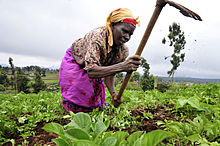Gender and food security

Gender inequality both leads to and is a result of food insecurity. According to estimates, girls and women make up 60% of the world's chronically hungry and little progress has been made in ensuring the equal right to food for women enshrined in the Convention on the Elimination of All Forms of Discrimination against Women. Women face discrimination both in education and employment opportunities and within the household, where their bargaining power is lower. Women's employment is essential for not only advancing gender equality within the workforce, but ensuring a sustainable future as it means less pressure for high birth rates and net migration. On the other hand, gender equality is described as instrumental to ending malnutrition and hunger.
Women tend to be responsible for food preparation and childcare within the family and are more likely to spend their income on food and their children's needs. Women also play an important role in food production, processing, distribution and marketing. They often work as unpaid family workers, are involved in subsistence farming and represent about 43% of the agricultural labor force in developing countries, varying from 20% in Latin America to 50% in Eastern and Southeastern Asia and Sub-Saharan Africa. However, women face discrimination in access to land, credit, technologies, finance and other services. Empirical studies suggest that if women had the same access to productive resources as men, women could boost their yields by 20–30%, raising the overall agricultural output in developing countries by 2.5 to 4%. While these are rough estimates, there would be a significant benefit of closing the gender gap on agricultural productivity. The gendered aspects of food security are visible along the four pillars of food security: availability, access, utilization and stability, as defined by the Food and Agriculture Organization.
The number of people affected by hunger is extremely high, with enormous effects on girls and women. There is sentiment that making this trend disappear should be a top priority for governments and international institutions. This is because food insecurity is an issue concerning equality, rights and social justice. Factors like capitalism, exploration of Indigenous lands all contribute to food insecurity for minorities and the people who are the most oppressed in various countries (women being one of these oppressed groups). Because girls and women are the most oppressed by the inequitable global economic processes that govern food systems and by global trends such as climate change, it is reflective of how institutions continue to place women in positions of disadvantage and impoverishment to make money and thrive on capitalizing the food system. When the government withholds food by raising its prices to amounts only privileged people can afford, they both benefit and are able to control the lower-class/marginalized people via the food market.
Comments
Post a Comment